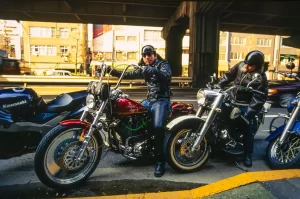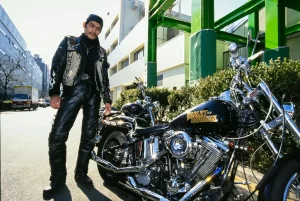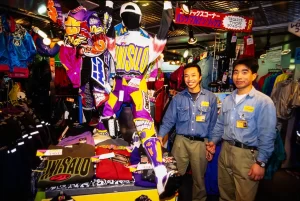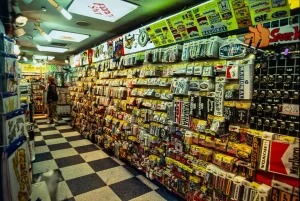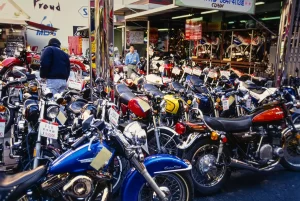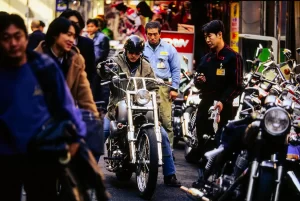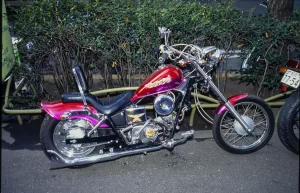The Ultimate Cure for Jetlag
David Dewhurst
Business trips to Japan were a regular part of my life in the 1990s and early 2000s. The twelve-hour flights and crippling jet lag were never much fun, but as I lay awake at 4 am staring at the ceiling of my tiny Tokyo hotel room, I was always excited about what had become a ritual whenever I was in Japan.
While first-time visitors might head to the amazing Meiji-Jingu shrine or the impressive Imperial Palace, my first stop was less traditional. Way less traditional. I’d jump on a JR train at Tokyo Central Station for an eight-minute ride north of the glitz of the Ginza to the little-known Ueno district. The few other tourists emptying out of the grey concrete station were usually heading for the Tokyo National Museum or the Ueno Zoo. I, on the other hand, was headed to the sleazier side of Ueno under the elevated expressway where the genteel visitors from Iowa and Florida didn’t dare venture. I was headed for the bike district.
Japan is unique in having many stores of a similar genre; all congregated in a single district of major cities. If you want anything to do with electronics in Tokyo, you should head to the Akihabara district, where the streets are lined with hundreds of tiny electronic stores. If you are looking for vintage fashion, you can head east of central Tokyo to the Shimokitazawa district, where clothes hang outside tiny stores and college students sip coffee in even tinier cafes.
The only clothes hanging outside stores in Ueno are almost always leather and black because the narrow streets here are lined with motorcycle stores. But let’s be clear: we are not talking about a typical Honda dealership you would find on the outskirts of Des Moines, Iowa. In Ueno, the bike shop fronts often don’t look big enough to house a taco stand, let alone a Honda Gold Wing. But that is the curious beauty of Ueno. It’s unlike anything else in the world.
There are a few larger stores where multiple small premises have been knocked through into something the size of a small American McDonalds. These bigger stores usually have a modernized façade with a few bikes lined up on the sidewalk. Almost everything else appears to be the size a watch repair kiosk in an American shopping mall. It’s also hard to see what’s inside these tiny stores because the windows are usually covered in colorful signs written in Kanji that describe all the wonders that await inside.
Most of the Ueno stores could be described as parts and accessory shops, but stepping inside one for the first time, you’d be forgiven for thinking you’d stumbled into Aladdin’s cave. With space at a premium, every square inch of these stores is stuffed to bursting with shiny moto parts. At first, it’s quite intimidating, and you find yourself jerking around like a baseball bobblehead doll.
I clearly remember the first Ueno store I ever visited. Hanging from the ceiling like Christmas icicle decorations were countless after-market exhaust systems. Chrome street pipes rubbed against stainless race designs and black-painted expansion chambers. Each one had a bright yellow, kanji-covered card describing its price. On the wall to the right were glass-fronted shelves crammed with smaller parts. A four-carb Keihin and manifold for a CB750 race bike sat above probably fifty different styles of aluminum rearsets. On the left wall were similar glass-fronted shelves with even more moto porn. The middle shelf had rows of exquisite high-domed four-stroke pistons for every imaginable brand, while the shelf below displayed complete gearsets for those looking to improve their race setup. They could also choose from twenty or thirty oil coolers and more cooling lines and AN fittings than I’d ever seen before.
Squeezing past the stage-three race motor on the floor and racks of every imaginable handlebar, I noticed a tiny stairway in the back corner. It resembled a prop from Hogwarts, and it led to an equally magical second floor that seemed to be constructed entirely from helmet boxes. Every square inch of the tiny space was crammed with Arai, Shoei, Bell, and countless Japanese brands I’d never seen before. Whether it was street, dirt, or adventure riding, this closet-sized space covered it all.
Up another flight of stairs was the first of two clothing sections. Again, squeezed tighter than a sardine can, the third floor had more black leather than a sixties British biker café. Everything from full racing leathers to stylish waistcoats, with hundreds of gloves to finish off the stylish ensemble.
They’d obviously figured that motocrossers were the fittest group of riders because they had to climb yet another set of narrow stairs to a fourth floor to find the nylon pants, shirts, and protective gear they were looking for. And if anyone had any energy left, there was a top floor brimming with books, magazines, and posters of every shape and size.
This was just one of countless similar stores that lined Ueno’s narrow streets. Each one had its own unique style, with some concentrating on a single product. A short walk under the elevated expressway was a bike tire specialist with racks of mainly street tires and just enough room between the shelves to perform on-the-spot tire changes. Just two doors down, a slightly larger store catered exclusively to the growing number of Japanese Harley-Davidson enthusiasts. There was little room for heavy American iron inside the shop, but there were walls full of bad-ass leather jackets, chaps, and all the other paraphernalia for the cruising crowd.
From a distance, those Japanese Harley riders look like their counterparts in America. Still, knowing the more reserved and genteel Japanese culture, it’s hard to imagine a bar-room brawl breaking out anywhere around Ueno. Instead, the Wideglides line up next to Suzuki 50s, RD350 Yamahas, and four-cylinder Honda sportbikes under the expressway overpass. There’s no tension in the air as the diverse groups mingle. They are all here because of motorcycles, and nobody really cares what motorcycle that might be.
The singular interest in two wheels might not be unique to Ueno, and the products on sale can probably be found anywhere in America or Europe. But what makes Ueno so unique is that all these people and all these parts are jammed into one tiny corner of a major world capital. It’s like having the convenience of Amazon Prime with the cozy feel of an English country store.

